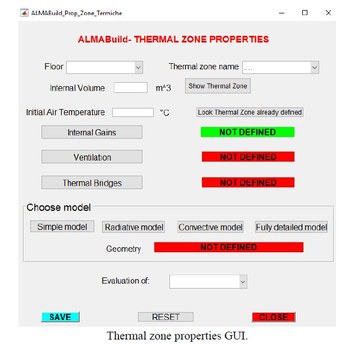Thermal zones definition
How to define thermal zones in a building

After having defined the weather data, the thermal properties of both opaque and clear envelope elements and the characteristics of eventual shading devices, data about the thermal zones in which the building is divided can be inserted. For this purpose a specific set of GUIs have been developed. Firstly, it is required to define the number of storeys composing the building, and to label each storey, starting from the groundfloor. Then, for each floor, labels of thermal zones located in the considered stage can be defined.
Now, the user can insert the main properties of each thermal zone, by means of the GUI Thermal Zone Properties. A pop-up menu is used for the selection of the thermal zone, and internal air volume and initial air temperature can be defined. On the contrary, internal gains profile, characteristics of air ventilation and thermal bridges are inserted by means of dedicated GUIs.
Moreover, the user can select the model by means of which the thermal zone is simulated:
- simple model
- convective/radiative model
The simple model
The simple model is the most used one; it links to the zone two temperature values: the convective temperature and the radiative temperature of the zone.
If the simple model is selected, it can be noted that the thermal zone is defined specifying for each building envelope element its orientation and area. These values have to be calculated manually.
The convective/radiative model
The convective model, as the radiative, is used for the determination of the spatial temperature distribution within a thermal zone.
These models take into account the convective airflows and the view factors for the estimation of the radiative heat fluxes among zone elements. The fully detailed model is adopted for the estimation of the spatial distribution of both the radiative and convective temperatures.
Finally, by means of a pop-up menu, the user can select the typology of evaluation that has to be performed for the considered thermal zone: it is possible to evaluate the temperature of the thermal zone or the ideal power that a HVAC system has to provide to the zone to guarantee a defined air temperature profile. This last option is available only for simple or radiative detailed models. Based on the typology of model selected by the user for the building energy simulation, different geometry informations are needed.